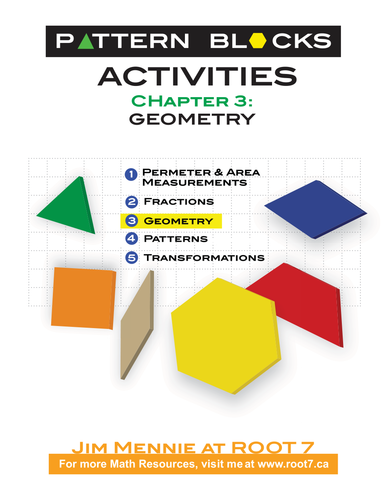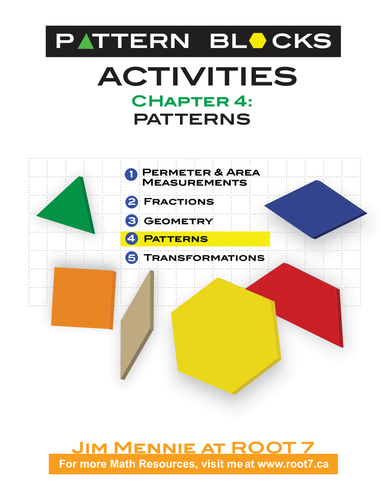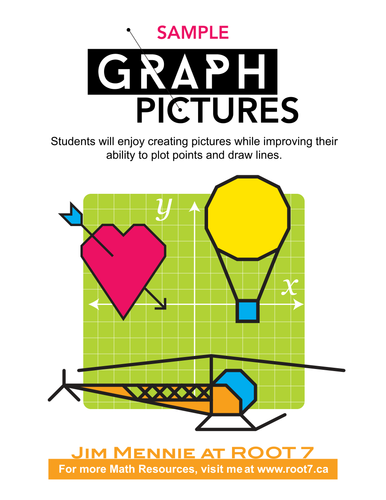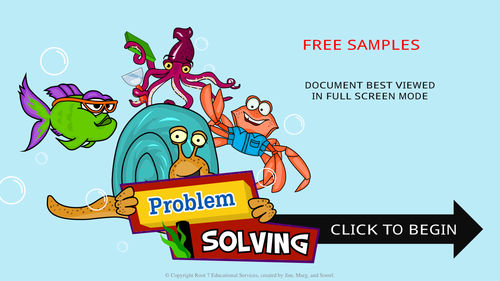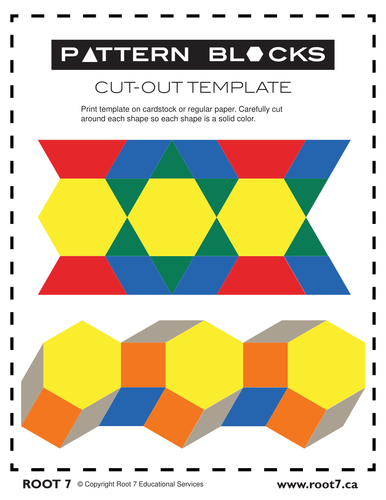
26Uploads
13k+Views
4k+Downloads
All resources

Pattern Blocks Chapter 3 - Geometry
Years of research on how children learn has shown that the use of manipulatives such as pattern blocks is a powerful tool for developing conceptual understanding of mathematics.
Students enjoy working with pattern blocks when they have been allowed time for free explorations. What seems like play to adults is an important part of building confidence and motivation in children.
Using Root 7’s Pattern Block resources enables students to be:
• Actively involved in doing math, which motivates them and builds confidence.
• Provided with excellent opportunities to work together, discuss mathematical ideas, and verbalize their thinking.
• Given concrete representations of mathematical ideas, thus providing a visual model to refer to.
• Provided with Extra Practice questions to extend and reinforce their knowledge and understanding.
How to use
• Assign one or more Activity questions to each student and allow them to work individually, in pairs or in groups
• Observe the students as they work and ask questions, or ask them to explain their work, to ensure they understand the mathematics
• Ensure they record their work as this helps them clarify their thinking and reinforce their understanding.
• The More Practice questions are important as they are designed to make the connection from “Hands-on” to “paper and pencil” ie from the concrete to the more abstract symbolic representation.
The activities in Chapter 3: Geometry helps students increase their knowledge and understanding of various concepts of Geometry including, properties of shapes, congruence, similarity, and symmetry.
Each unit includes Teacher Notes and Answers.

Pattern Blocks Chapter 4 - Understanding Patterns
Years of research on how children learn has shown that the use of manipulatives such as pattern blocks is a powerful tool for developing conceptual understanding of mathematics.
Students enjoy working with pattern blocks when they have been allowed time for free explorations. What seems like play to adults is an important part of building confidence and motivation in children.
Using Root 7’s Pattern Block resources enables students to be:
• Actively involved in doing math, which motivates them and builds confidence.
• Provided with excellent opportunities to work together, discuss mathematical ideas, and verbalize their thinking.
• Given concrete representations of mathematical ideas, thus providing a visual model to refer to.
• Provided with Extra Practice questions to extend and reinforce their knowledge and understanding.
How to use
• Assign one or more Activity questions to each student and allow them to work individually, in pairs or in groups
• Observe the students as they work and ask questions, or ask them to explain their work, to ensure they understand the mathematics
• Ensure they record their work as this helps them clarify their thinking and reinforce their understanding.
• The More Practice questions are important as they are designed to make the connection from “Hands-on” to “paper and pencil” ie from the concrete to the more abstract symbolic representation.
The activities in Chapter 4: Patterns helps students increase their knowledge and understanding of various concepts of Patterns including, creating and extending pattern, determining the 100th and nth terms.
Each unit includes Teacher Notes and Answers.

Pattern Blocks - Free Sample
Years of research on how children learn has shown that the use of manipulatives such as pattern blocks is a powerful tool for developing conceptual understanding of mathematics.
Students enjoy working with pattern blocks when they have been allowed time for free explorations. What seems like play to adults is an important part of building confidence and motivation in children.
Using Root 7’s Pattern Block resources enables students to be:
• Actively involved in doing math, which motivates them and builds confidence.
• Provided with excellent opportunities to work together, discuss mathematical ideas, and verbalize their thinking.
• Given concrete representations of mathematical ideas, thus providing a visual model to refer to.
• Provided with Extra Practice questions to extend and reinforce their knowledge and understanding.
How to use
• Assign one or more Activity questions to each student and allow them to work individually, in pairs or in groups
• Observe the students as they work and ask questions, or ask them to explain their work, to ensure they understand the mathematics
• Ensure they record their work as this helps them clarify their thinking and reinforce their understanding.
• The More Practice questions are important as they are designed to make the connection from “Hands-on” to “paper and pencil” ie from the concrete to the more abstract symbolic representation.
The activities in this free resource give a taste of the content and format of the 5 Pattern Block chapters.
Each chapter includes Teacher Notes and Answers.

Graph Pictures - Sample
The ability to plot points and draw lines on graph paper is important in the fields of Linear Algebra, Coordinate Geometry, Computer Graphics, Statistics, and many branches of Science.
This resource provides an easy, interesting, and fun way to for students to develop and practice these skills.

Math Problem Solving Strategies - Free Sample
Two statements that can be found in almost any math curriculum are:
Students learn best if they are actively involved in their learning.
Students should be able to apply various strategies to solve problems.
This Free Sample provides a sample of the problem solving available in our 9 units focusing on 8 problem solving strategies plus a series of Mixed Problems in which students decide on the most appropriate strategy to solve each problem.

